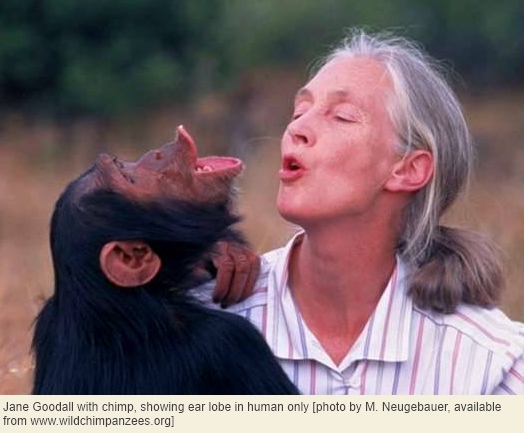The Bio-edge starts with the human body.
So many enigmatic body parts to choose from: chin, appendix, eye whites, thumb, foot, penis, mammaries, sinuses, kidneys . . .
No other species on Earth has a chin such as ours, and biologists can only surmise that this bony projection buttresses our mandible – which is relatively weak on our soft diet – against knocks. If so, the chin may be an unappreciated mark of our uniquely human dependence on cooking, and as expressive of this dietary peculiarity as the now-familiar ‘thumb’[1] of the giant panda is of a diet of bamboo. Our vermiform appendix may seem vestigial but this assumption doesn’t stand up to scrutiny; only recently have some serious hypotheses on its real function emerged. The whites of our eyes seem unremarkable until compared with the dark-pigmented scleras found in the apes closest to us. The opposability of our thumb feels like a high achievement but anatomically is a mere tweak of a hand that remains superficially similar to the amphibian forefoot and the primate hindfoot. As for our foot, this most extraordinary part of our body is surprisingly ancestral, having evolved when our brain was still baboon-size. Moving back up the body: the human species anomalously lacks a baculum[2], leaving us with the puzzle of why the small penis of the gorilla would need bony reinforcement while our large penis would not. The presence of rudimentary mammary glands in men is an enduring anomaly taken for granted because most other mammals likewise retain nipples. For which purpose does the human cranium, in parallel with many other mammals, contain air-filled sinuses within the bony housing of the ear? And, stepping right back to the level of tetrapods generally: neither biology nor medicine has a coherent theory on the main function of the kidney, one of the most expensive of organs metabolically.
We could start anywhere in this list and more of puzzles. But we’ve chosen something almost arcane: the ear lobe.
Is the ear lobe restricted to humans among primates? The basic anatomical research required, i.e. dissection of the auricle cartilages, remains to be done. But the photographic evidence is suggestive.

If the ear lobe is distinctively human, is it a feature of the genus Homo in general or Homo sapiens in particular? This question may be relevant to e.g. Homo neanderthalensis, which lacked the human chin. Given the vulnerability of flaps of skin to frostbite and the frigidity to which our extinct congener was adapted, can we just assume that this species shared our ear lobe? And if an ear lobe was present, was it accessorised as in H. sapiens? As far as we know, archaeologists have lacked even a search-image for ear lobe artefacts in Neanderthal graves.

Thinking laterally is something that scientists are seldom trained to do. But it’s circumstantially that we researched our chapter, ‘Lobulated ears: natural selection gone bionic?’ in our forthcoming e-book. And, come to think of it, the very position of the ear lobes to each side of the brain may almost seem like a pictogram for the whole approach of thinking laterally to solve intellectual puzzles.
Is the ear lobe – an appendage small enough to fit snugly between our opposable thumb and forefinger – among the anatomical features that make us distinctively human? It would be an overstatement that accessorisation of the ear lobe is a human universal in the same sense as marriage. However, there has been a bewildering diversity of ear lobe rings, hoops, spools, plugs and tubes worldwide, and the ethnography and archaeology of this aspect of culture are works in progress. And, although Science has perhaps been slow to appreciate a body part so drab when naked, ancient civilisations assumed that piercing the ear lobes was a creative gift shared with Divinity.

We look forward to meeting again in our forthcoming e-book in which we interview the Human Ear Lobe. As ever, the thoughts of readers are welcome in the comments to this blog-post.
—-
We thank Friderun Ankel-Simons for her generous discussion prior to this posting.
***
All text and images appearing in this blog are subject to copyright, except those images explicitly stated to be in the public domain. You are not free to use any photographs, for any purpose, without receiving written permission from the copyright holder.
1 sesamoid, which functions, despite being a wrist bone, as a sixth finger
2 penis bone, present in apes and monkeys

